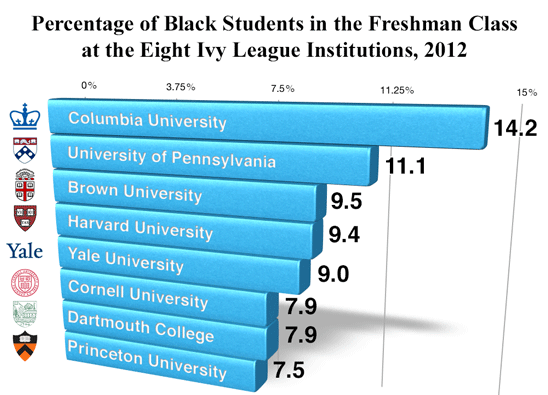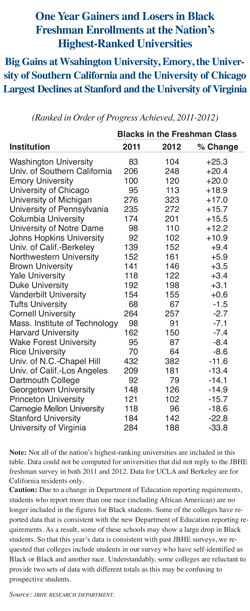![]() Once more, this year The Journal of Blacks in Higher Education has completed its survey of admissions offices at the nation’s highest-ranked research universities. For the 20th consecutive year, we have calculated and compared the percentages of African-American students in this fall’s entering classes. As in the past, our survey publishes information on the total number of African-American applicants at the various institutions, their acceptance rates, enrollment numbers, and yield rates (the percentage of students who eventually enroll in the colleges at which they were accepted).
Once more, this year The Journal of Blacks in Higher Education has completed its survey of admissions offices at the nation’s highest-ranked research universities. For the 20th consecutive year, we have calculated and compared the percentages of African-American students in this fall’s entering classes. As in the past, our survey publishes information on the total number of African-American applicants at the various institutions, their acceptance rates, enrollment numbers, and yield rates (the percentage of students who eventually enroll in the colleges at which they were accepted).
Five years ago Columbia University headed the JBHE rankings for the first time. Now, for the sixth year in a row, Columbia has the highest percentage of Black first-year students among the 30 highest-ranking universities in the nation. There are 201 Black freshmen at Columbia this fall. They make up 14.2 percent of the incoming class.

In 2010, there were 202 Black first-year students at Columbia. They made up 14.5 percent of the incoming students. This was the highest percentage of Black students in the entering class at a leading research university in the history of the JBHE survey. Last year, while Columbia remained at the top of our rankings, the percentage of Black students in the entering class dropped t0 12.5 percent. Only eight years ago in 2004, Blacks made up only 6.8 percent of the entering students at Columbia University.
For the second straight year, Duke University finished second in the rankings. There are 198 Black freshmen at Duke this fall. They make up 11.5 percent of the entering class, up from 11.1 percent a year ago.
The University of Pennsylvania jumped from seventh place last year to third place in this year’s survey. The percentage of Black students in the entering class at Penn increased from 9.5 percent in 2011 to 11.1 percent this year.
All of the other top research universities in our survey have entering classes that are less than 10 percent Black.

The University of North Carolina at Chapel Hill has led our survey six times. Last year the university ranked in third place, improving from fifth place in 2010. In 2012, there are 382 Black freshmen at Chapel Hill making up 9.8 percent of the first-year class. This places the university in fourth place in this year’s survey.
Vanderbilt University holds the fifth position in our survey with a first-year class that is 9.6 percent Black. This is an identical percentage to last year’s entering class at Vanderbilt.
Brown University edged out Harvard University for the sixth spot in our survey. This drops Harvard to seventh place overall and fourth place among the eight Ivy League universities. Yale ranks eighth overall and fifth in the Ivy League with an entering class that is 9 percent Black.
Emory University, the Massachusetts Institute of Technology and Stanford round out the top 10. Stanford and MIT are tied for the tenth position with an entering class that is 8 percent Black. All other universities in our survey have a freshman class that is less than 8 percent Black.
The bottom two places in our survey belong to the UCLA and the University of California at Berkeley, universities that are prohibited by state law from considering race in their admissions decisions. At the University of Michigan, which also is prohibited by state law from considering race in admissions, there was improvement this year. The percentage of Blacks in the entering class at Michigan increased from 4.6 percent to 5.2 percent. This is still significantly below the level of Black enrollments that existed before the ban was enacted. A federal appeals court has ruled that the state ban violates the U.S. Constitution. But the ban remains in effect until the U.S. Supreme Court decides whether to hear the appeal.

Gainers and Losers
For the 29 high-ranking universities for which we have data for both this year and last, 15 universities showed gains over last year in Black student first-year enrollments. Fourteen high-ranking universities had declines in their number of entering freshmen who are Black.
The biggest percentage gain was at Washington University in St. Louis. There are 1o4 Black freshmen at Washington University this year, up from 83 a year ago. This is a gain of 25.3 percent. The University of Southern California and Emory University each had a 20 percent gain in the number of entering Black students. The University of Chicago, the University of Michigan, the University of Pennsylvania, and Columbia University all posted gains of at least 15 percent. The University of Notre Dame and Johns Hopkins University also posted significant gains in Black freshmen.
The largest decline was at the University of Virginia. There, the number of Black first-year students dropped from 284 in 2010 to 188 this year. Stanford and Carnegie Mellon also had significant declines.
A Note of Caution on Universities Reporting a Sharp Drop in Black Freshmen
Before we continue with the results, it is important to mention a change in the way that the U.S. Department of Education collects data on the race of undergraduates. In the past students who reported more than one race (including African American) were included in the figures for Black students. This is no longer the case. Thus, students who self-identify as biracial or multiracial with some level of African heritage are no longer classified as Black. JBHE surveys have always asked respondents to include all students who self-identify as having African heritage including those who are actually from Africa. So we can compare our current data to past JBHE surveys we have continued to asked colleges and universities to include all students who identify themselves as having African heritage.
However, some colleges and universities do not want to publish a different set of statistics than those that appear in official U.S. Department of Education assessments. As a result, some of the colleges have reported data that is consistent with the new Department of Education reporting requirements. Therefore, some of these schools may show a large drop in Black students.
JBHE has always maintained that biracial, multiracial, and Black students from Africa add to the diversity of a college campus. And including these students in our figures offers college-bound Black students a better idea of what they can expect at a given college or university. We admit that it is a difficult issue and we understand to avoid confusion some universities only want to report data that is consistent with the U.S. Department of Education data. Other universities who are insistent on reporting only data that is compatible with the Department of Education reporting requirements are reluctant to report data to JBHE because their numbers will be lower than colleges and universities that include biracial and multiracial students with African heritage in their figures.
Perhaps, the best solution would be to expand our survey to include both sets of figures. We invite readers to comment.
Back to the Numbers
It is well recognized that the percentage of Black applicants who actually receive invitations to join the freshman class is a valuable gauge of an institution’s commitment to racial diversity. Yet this figure is regarded as the most sensitive of all admissions data. This is particularly true for some of the very highest-ranked institutions.
Of the 29 highest-ranked universities that responded to our survey, 11 declined to reveal their Black student acceptance rates. Unquestionably, public and private litigation threats to affirmative action policies in college admissions have been a factor in producing this sensitivity. With this in mind, admissions officers — who on the whole are solidly supportive of affirmative action — have apprehensions when statistics on Black admissions are made available to the public. There are standard concerns too that racial conservatives on faculties and among alumni and trustees may interpret the figures as suggesting a so-called dumbing down of academic standards and a favoring of “unqualified” Blacks over perhaps more qualified Whites.
But, at the same time it is critical to keep in mind that an institution’s high Black acceptance rate often indicates nothing more than the fact that the admissions office of a given institution has a very strong and well-qualified Black applicant pool.
At 11 of the 18 universities that supplied acceptance rate data to JBHE, the Black student acceptance rate was higher than the acceptance rate for all students. In some cases the differences were significant but larger disparities have been seen in prior surveys. Seven of the high-ranking universities we surveyed had Black acceptance rates that were in fact lower than the overall acceptance rate. At the University of California at Berkeley and the University of California at Los Angeles, both of which were prohibited from taking race into account during the 2012 admissions process, the Black acceptance rate was significantly below the rate for all accepted students.











I think it would be a great idea to include both the figure sets for full black students and mixed students! I am a mixed student at one of the listed Universities, and I think it would be very interesting to see both sets of statistics. I agree with JBHE’s view on how multiracial students add to the diversity on a campus, and I think it’s kind of offensive that the new rules don’t consider us to be “black.”
My parents will not support me unless I attend an HBCU
I luv HBCU’s
Notre Dame prosepective student here!! Love it! I hope I’ll be able to get in 🙂
I highly recommend all prospective students to consider HBCUs in their choices for undergrad. Nobody…Nobody will love you and nurture you like a HBCU. The research at the above institutions doesn’t apply until grad level and the tuition is extremely expensive. In addition, the best companies still specifically seek top HBCU grads as the inside track in recruiting. Just my 2 cents